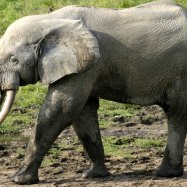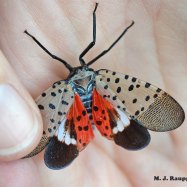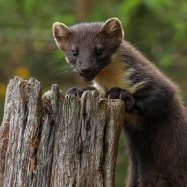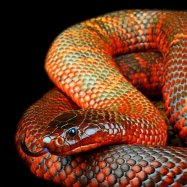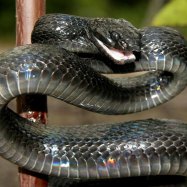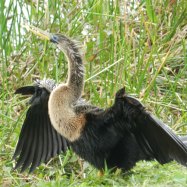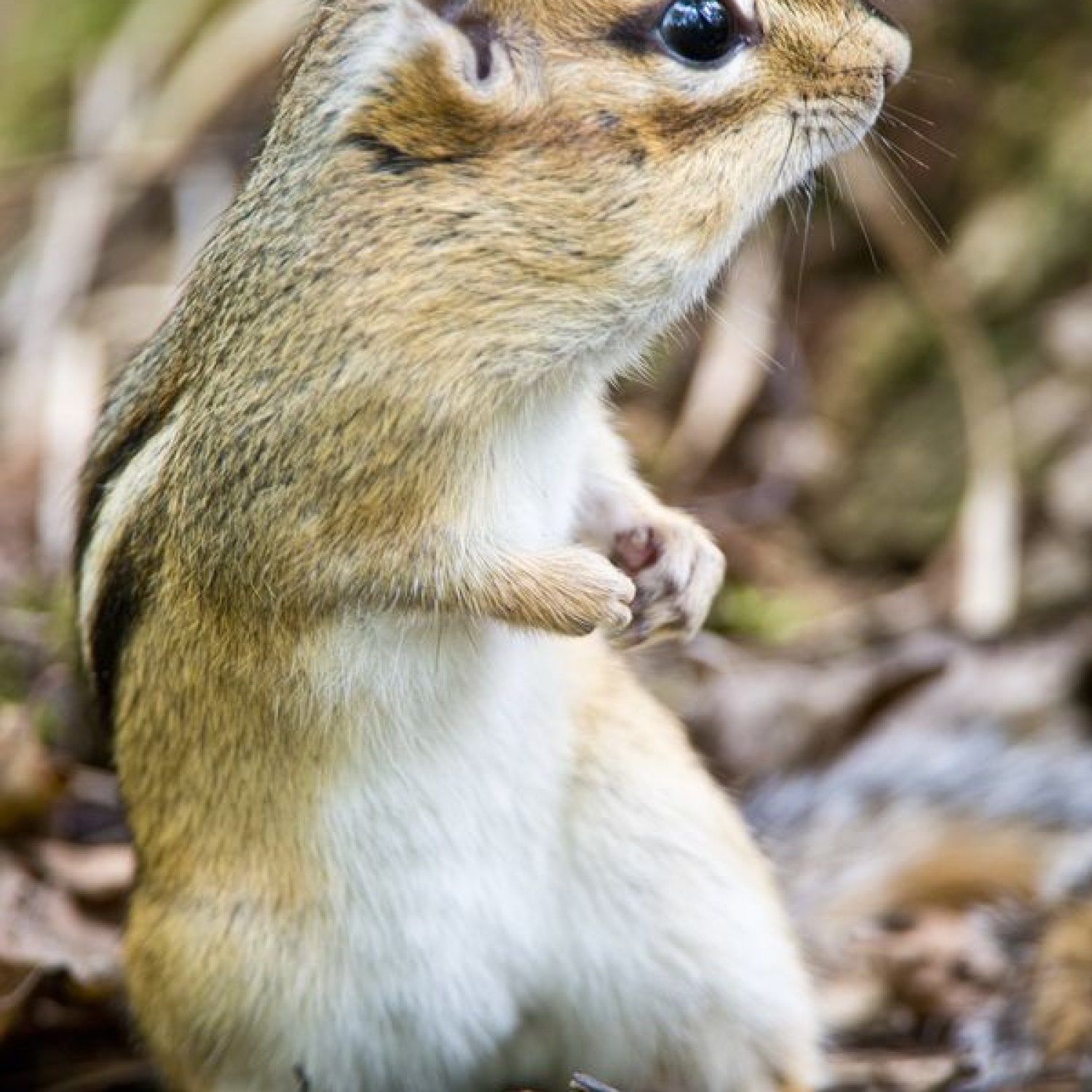
Eastern Chipmunk
5 to 6.5 inches (13 to 17 cm)
The Eastern Chipmunk is a small and compact mammal found in Eastern US and southeastern Canada. They measure from 5-6.5 inches (13-17 cm) and belong to the Sciuridae family. These energetic creatures are known for their adorable striped appearance and love for nuts and seeds. Spot one on your next hike and witness their quick movements and keen foraging skills. #EasternChipmunk #Sciuridae #adorablewildlife
Animal Details Summary:
Common Name: Eastern Chipmunk
Kingdom: Animalia
Habitat: Deciduous forests, shrublands, and suburban areas
The Adorable Eastern Chipmunk: A Fascinating and Mischievous Creature in Eastern North America
Have you ever encountered a small, furry creature with a playful and mischievous nature in the eastern part of North America? Chances are, you have encountered the charming Eastern Chipmunk. These little creatures are beloved for their adorable features and fun-loving personalities.Scientifically known as Tamias striatus, the Eastern Chipmunk is a member of the kingdom Animalia, phylum Chordata, and class Mammalia. They belong to the order Rodentia, which includes other well-known rodents such as squirrels and mice Eastern Chipmunk. These chipmunks are part of the Sciuridae family, which includes other species of chipmunks, ground squirrels, and tree squirrels.
Native to the eastern region of North America, including the United States, Canada, and Mexico, the Eastern Chipmunk is a common sight in deciduous forests, shrublands, and even suburban areas. Their agile bodies and omnivorous feeding habits make them adaptable to various environments, allowing them to thrive in both urban and rural settings.
Habitat and Distribution
The Eastern Chipmunk can be found in the eastern United States and southeastern Canada. They are typically seen in forests, woodland edges, and grassy areas. However, they are also known to venture into urban and suburban neighborhoods, especially those with ample shrubs and trees.In these urban environments, Eastern Chipmunks can often be found in gardens, lawns, and parks. They are also known to build their burrows under sheds, woodpiles, and porches. They are not picky and can adapt to a variety of habitats as long as they can find suitable food and shelter Eurasian Lynx.
Feeding & Diet
Eastern Chipmunks are omnivores, meaning they eat a diet composed of both plant and animal matter. They have a varied diet, consisting of nuts, seeds, berries, insects, and even small birds and eggs. These opportunistic foragers will eat anything they can find, depending on the season and availability of food.In the spring and summer, Eastern Chipmunks predominantly feed on buds, flowers, and insects. As fall approaches, they start storing food for the winter. They are known to have cheek pouches which they use to carry food back to their burrows, where they store it for the colder months. During this time, their diet mainly consists of nuts, seeds, and fungi.
Physical Appearance
The Eastern Chipmunk has a small and compact body, measuring 5 to 6.5 inches (13 to 17 cm) in length. Their body is covered in reddish-brown fur, with five distinct black and white stripes running down their back. Their belly is a lighter shade of brown, and they have white underparts.They have a long bushy tail, which they use for balance and communication. Their eyes are large and round, giving them excellent vision. Their cheeks are expandable, which allows them to carry food up to three times their head size. This feature also helps to differentiate them from other chipmunk species, which do not have this ability.
Behavior and Social Structure
Eastern Chipmunks are solitary animals, and they tend to spend most of their time alone. They are diurnal, meaning they are active during the day and spend their nights sleeping in their burrows.These chipmunks are known for their playful and curious nature. They are often seen scurrying around, digging and jumping in their habitats. They are also skilled climbers and can easily navigate their way through trees and branches.
These creatures are territorial, and each individual has a home range, which they defend against other chipmunks. However, during the breeding season, male chipmunks will try to attract females by singing and chasing each other. Once they have mated, the female will prepare a burrow for her offspring.
Conservation Status
The Eastern Chipmunk is considered a species of "least concern" by the International Union for Conservation of Nature (IUCN). This is due to their widespread distribution and adaptability to different habitats. However, they do face threats from habitat loss and fragmentation, as well as predation from domestic cats and other predators.Fortunately, Eastern Chipmunks have a high reproduction rate, with females giving birth to two litters a year, each consisting of 2-8 offspring. This has helped to maintain a stable population for these creatures.
In Popular Culture
Eastern Chipmunks are known to be popular characters in children's books and cartoons. The most famous of these is Alvin and the Chipmunks, a fictional musical group of chipmunks that have entertained generations since the 1950s.In the world of competitive eating, the Nathan's Famous Hot Dog Eating Contest includes a "chipmunk rule," inspired by the behavior of these creatures to stuff food in their cheeks. The rule states that participants are prohibited from emptying their mouth during the competition.
Final Thoughts
The Eastern Chipmunk is a fascinating and adorable creature, known for its playful and mischievous nature. These small rodents have captured the hearts of many with their curious behavior, cheeky personality, and amusing antics.As inhabitants of the vast eastern region of North America, the Eastern Chipmunk serves a vital role in balancing the ecosystem. While their populations remain stable, it's essential to preserve their natural habitats and ensure their survival for generations to come.

Eastern Chipmunk
Animal Details Eastern Chipmunk - Scientific Name: Tamias striatus
- Category: Animals E
- Scientific Name: Tamias striatus
- Common Name: Eastern Chipmunk
- Kingdom: Animalia
- Phylum: Chordata
- Class: Mammalia
- Order: Rodentia
- Family: Sciuridae
- Habitat: Deciduous forests, shrublands, and suburban areas
- Feeding Method: Omnivorous
- Geographical Distribution: Eastern North America
- Country of Origin: United States, Canada, Mexico
- Location: Eastern United States and southeastern Canada
- Animal Coloration: Reddish-brown on the upper body with five dark stripes
- Body Shape: Small and compact
- Length: 5 to 6.5 inches (13 to 17 cm)
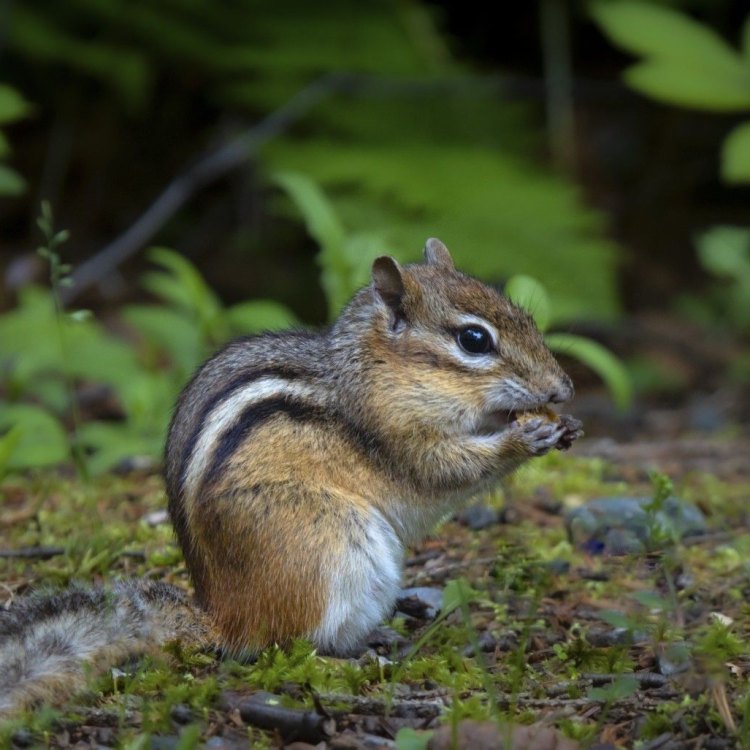
Eastern Chipmunk
- Adult Size: 5 to 6 inches (13 to 15 cm)
- Average Lifespan: 2 to 3 years in the wild, up to 8 years in captivity
- Reproduction: Sexual
- Reproductive Behavior: Mating occurs in early spring and late winter
- Sound or Call: Chipping vocalizations
- Migration Pattern: Non-migratory
- Social Groups: Solitary or in small family groups
- Behavior: Diurnal and active
- Threats: Predators, habitat loss, and climate change
- Conservation Status: Least Concern
- Impact on Ecosystem: Seed dispersers
- Human Use: None
- Distinctive Features: Cheek pouches for storing food
- Interesting Facts: Eastern Chipmunks can stuff their cheek pouches with food up to three times the size of their heads.
- Predator: Foxes, hawks, snakes, and domestic cats
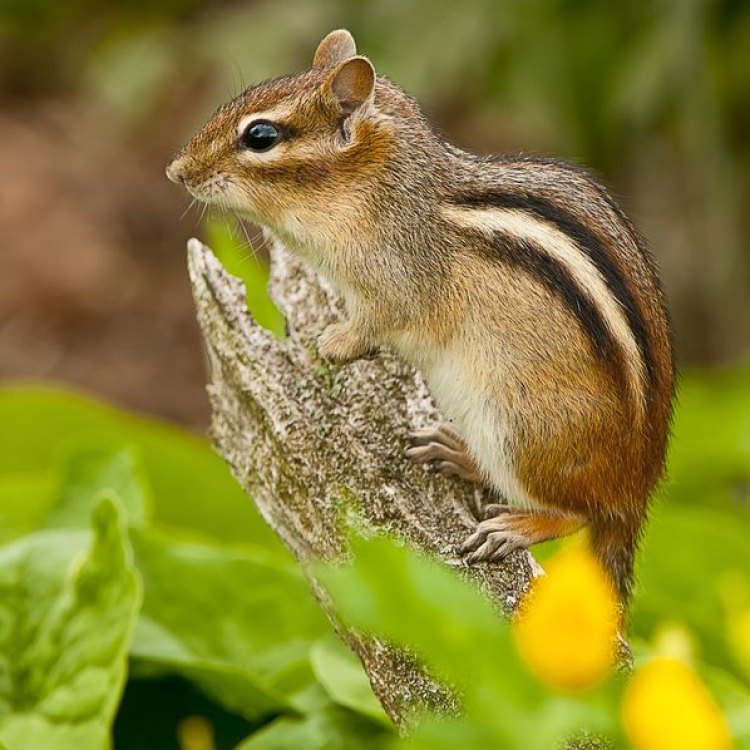
Tamias striatus
The Fascinating World of Eastern Chipmunks: Facts, Features, and Conservation
The Eastern Chipmunk (Tamias striatus) is a small but fascinating mammal found throughout the eastern and central regions of North America. With their charming appearance and quirky behaviors, these tiny creatures have captured the hearts of many, making them a beloved species among nature enthusiasts. But beyond their adorable appearance, there is much more to discover about these small rodents. In this article, we will delve into the world of Eastern Chipmunks, exploring their unique features, behavior, impact on the ecosystem, and conservation efforts PeaceOfAnimals.Com.Size and Lifespan
The Eastern Chipmunk typically measures between 5 to 6 inches (13 to 15 cm) in length, making them one of the smallest members of the squirrel family. They have a round body, short legs, and a bushy tail that helps them maintain balance while climbing trees and scurrying across the forest floor.
In the wild, Eastern Chipmunks have an average lifespan of 2 to 3 years, but they can live up to 8 years in captivity. However, their lifespan heavily depends on various factors, such as food availability, habitat quality, and predator presence.
Reproductive Behavior
Eastern Chipmunks are sexually reproductive animals, meaning that they require a mate to produce offspring. Mating usually occurs in early spring or late winter when the females come out of hibernation. During this time, they emit a specific scent that attracts males and engages in courtship rituals such as chasing and "chipping" vocalizations.
Once the mating is successful, the female will give birth to a litter of 3 to 5 babies after a gestation period of 31 days. The newborns are blind, hairless, and completely dependent on their mother for survival European Goldfinch. They will open their eyes after three weeks and will be weaned off their mother's milk at 6 weeks. The young Eastern Chipmunks will leave their mother's burrow at 8 weeks and become independent.
Sound or Call
The Eastern Chipmunk is known for its distinctive chipping vocals, which are a series of high-pitched "chip" sounds used to communicate with other chipmunks. These vocalizations serve different purposes, such as warning others of predators, identifying territorial boundaries, and signaling for courtship.
Migration Pattern and Social Groups
Unlike many other species of chipmunks, Eastern Chipmunks are non-migratory, meaning that they do not undertake long-distance journeys to find food or escape harsh weather conditions. They prefer to stay in their chosen habitat, which provides all their essential needs.
Eastern Chipmunks are mostly solitary animals, but they have been observed to form small family groups during the breeding season. These groups consist of one adult male, one or more females, and their offspring. The members of a family group will share the same burrow system, food sources, and will help defend their territory against intruders.
Behavior and Adaptations
Eastern Chipmunks are diurnal animals, meaning that they are most active during the day and sleep at night. They have keen senses, including excellent vision and a sharp sense of smell, which help them detect predators and locate food. These rodents are also agile climbers and can run at high speeds with their small but powerful legs.
One of the most interesting behaviors of Eastern Chipmunks is their cheek pouches, which are used to store food. These cheek pouches can stretch to three times the size of their heads, allowing them to gather and transport large amounts of food to their burrows. These pouches are essential for Eastern Chipmunks, as they often live in areas with harsh winters where food is scarce. They will gather and store food in their burrows, relying on their stash during the winter months when they hibernate.
Threats and Conservation Status
Eastern Chipmunks face various threats, with predators being the biggest danger to their survival. Natural predators of Eastern Chipmunks include foxes, hawks, snakes, and domestic cats. These animals prey on chipmunks for food and contribute to natural population control. However, human activities such as habitat loss due to urbanization and climate change also pose a significant threat to Eastern Chipmunks. Destruction of their habitat and changes in weather patterns can affect their food sources and hibernation cycles, leading to a decline in their population.
Despite these threats, the Eastern Chipmunk is currently listed as "Least Concern" on the IUCN Red List, meaning that they are not at immediate risk of extinction. However, ongoing efforts are being made to protect their habitat and raise awareness about the importance of these small but crucial creatures in the ecosystem.
Impact on the Ecosystem
Eastern Chipmunks may be small, but they play a vital role in their ecosystem. As seed dispersers, they have a significant impact on the growth and distribution of plants throughout their habitat. They gather and store seeds in their cheek pouches, carrying them to various locations as they forage for food. These seeds can then germinate and grow into new plants, helping to maintain the diversity of plant life in the forest.
Apart from seed dispersal, Eastern Chipmunks also serve as prey for many predators, contributing to the balance of the food chain. Their burrows also create shelter and nesting spaces for other animals such as reptiles, amphibians, and insects, further emphasizing their crucial role in the ecosystem.
Interesting Facts about Eastern Chipmunks
Beyond their essential role in the ecosystem, there are some fascinating facts about Eastern Chipmunks that make them stand out from other animals. Here are a few interesting tidbits about these charming creatures that you may not know:
- Eastern Chipmunks can stuff their cheek pouches with food up to three times the size of their heads, making them one of the most efficient food storers in the animal kingdom.
- These cheek pouches are not just used for food storage. Eastern Chipmunks also use them to transport nesting materials, such as leaves and grass, back to their burrows.
- They have a unique ability to open and close their ears, allowing them to hear more clearly and protect their ears from dirt and debris while digging.
- Eastern Chipmunks have excellent spatial memory and can remember where they have hidden their food stash for several months.
- These rodents are expert escape artists and can run at speeds of up to 21 km/h to evade predators. They can also use their dense fur as camouflage, blending in with their surroundings.
- Eastern Chipmunks are nomadic animals, meaning that they do not have a specific permanent home, but instead, they move between different burrows depending on food availability and weather conditions.
Predators of Eastern Chipmunks
Despite their cute appearance and elusive behavior, Eastern Chipmunks have various predators that pose a threat to their survival. As mentioned earlier, foxes, hawks, snakes, and domestic cats are natural predators of Eastern Chipmunks. These animals prey on chipmunks for food, and their presence serves as a form of natural population control.
However, human activities such as habitat destruction, hunting, and roadkill also contribute to the decrease in Eastern Chipmunk populations. It is essential to raise awareness about the impact of these activities on the ecosystem and take measures to reduce our negative impact on these creatures.
In conclusion, Eastern Chipmunks may be small, but they play an essential role in our ecosystems. From their unique adaptations to their crucial impact on seed dispersal, these rodents are a vital part of the intricate web of life in the forests of North America. As responsible stewards of the environment, it is our responsibility to protect and preserve these charming creatures for future generations. By understanding their behaviors, threats, and importance in the ecosystem, we can work together to ensure a thriving future for the Eastern Chipmunks.
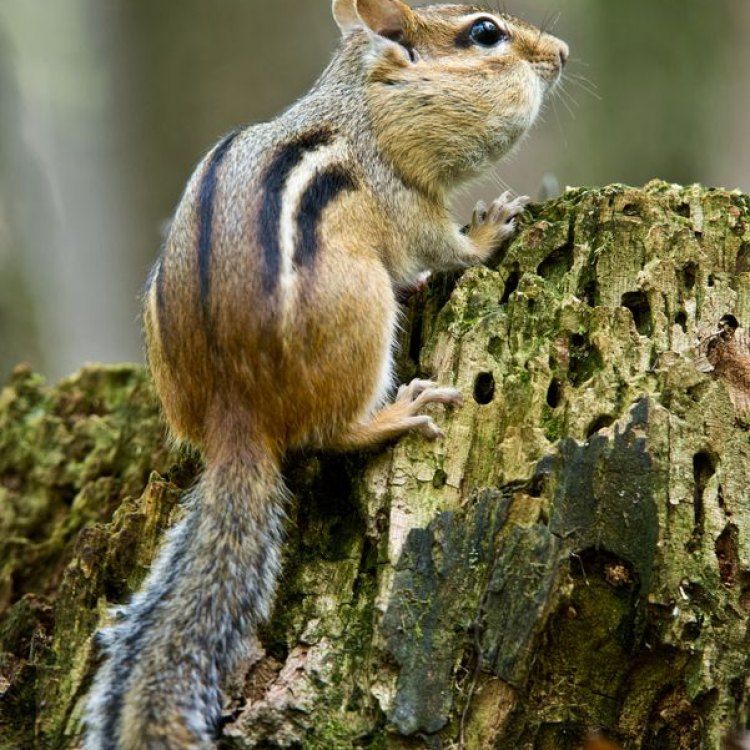
The Adorable Eastern Chipmunk: A Fascinating and Mischievous Creature in Eastern North America
Disclaimer: The content provided is for informational purposes only. We cannot guarantee the accuracy of the information on this page 100%. All information provided here may change without prior notice.

